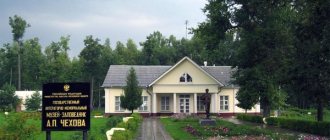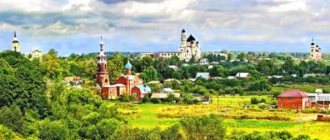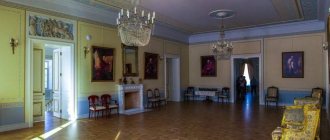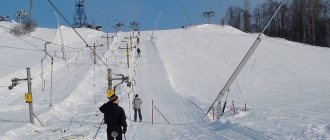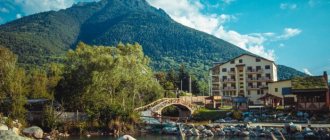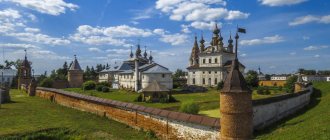Kozelsk, also known as the “evil city,” received its nickname in 1238 from Batu Khan, who lost almost half of his army and three sons here. Then only 300 Kozel residents held back the ten thousand Mongol army for almost two months. Due to its location, the city was constantly at the center of military operations, for which in 2009 it was awarded the title “City of Military Glory.”
Leo Tolstoy visited the city three times. Here he collected proverbs and sayings for “The Power of Darkness”, wrote “Hadji Murat” and his last article “The Real Remedy”. Ivan Turgenev created “The Dog” in Kozelsk, and Fyodor Dostoevsky described the city itself and its inhabitants in “The Brothers Karamazov”. “The Evil City” was also visited by Mikhail Prishvin, Dmitry Furmanov, Nikolai Gogol, Alexander Pushkin. Bulat Okudzhava was a teacher at one of the schools near Kozelsk, and later wrote his first album here.
Parks, waterfalls, caves, estates - all the most interesting things you can go to from Kozelsk, in this review of attractions in the Kaluga region.
Important information about Kozelsk
Kozelsk is located in a picturesque corner on the banks of the Zhizdra River. It is separated from the regional center - Kaluga by only 72 km.
If you look into its history, it turns out that it appeared even before Moscow. True, only for one year.
We heard about the events that brought historical glory to the city in school lessons, where we were told about the invasion of Batu in 1238. Returning from another campaign, the khan decided to take a small town that came along the way. But a surprise awaited him. Residents of Kozelsk defended themselves for 7 weeks. The facts speak about their heroism:
- About 4,000 Mongols were killed on the battlefield. Among them were close relatives and friends of Batu.
- Even cities such as Vladimir and Ryazan could not resist for more than 5 and 10 days.
The Khan's revenge was cruel - the remaining population was destroyed. They did not spare the elderly, women or children. And Prince Vasily of Kozel (at the age of 12) was ordered to be drowned in blood. Batu was so angry that he ordered the name of Kozelsk not to be mentioned and called it “Evil City.”
Thanks to this event, the city was awarded the title “City of Military Glory” in 2009. Episodes of the Great Patriotic War also affected this decision.
In memory of the defenders of the city, a monument was erected on the Heroes of Kozelsk Square
Nearby there is a long wall with drawings related to the history of the city. A commemorative 10-ruble coin, issued in 2013 in the “Cities of Military Glory” series, is dedicated to Kozelsk.
In recent years, there have been disputes between historians and archaeologists about the presence of ancient settlements on the modern territory of the city.
After excavations in 1992, archaeologists suggested that the city (XI-XIII centuries) was located in a different place, since no traces of ancient Russian times were found. However, employees of the Kaluga Regional Museum and workers of the Ugra National Park carried out excavations covering a larger area. They were able to provide evidence that settlements of Vyatichi from the squad of Yuri Dolgoruky lived on the banks of the Zhizdra River.
These warriors gave the future city such an unusual name. There are 2 versions:
- The most common hypothesis is that it is associated with the words “goats” (construction devices) and “forest”. In ancient times the city was called Kozelesk.
- But there is another interpretation - the basis is the roots of “Khazar” and “Elets” (forest). Historians suggest that the Vyatichi indicated their successful conquest of lands from the Khazars.
Over the next 2 centuries, Kozelsk belonged to the Karachev principality, existed as a separate Kozelsky fief, and belonged to the Lithuanians and Russian princes. Survived repeated fires.
Only in 1494 did it finally return to Rus'. During the time of Ivan the Terrible, changes took place to strengthen Kozelsk:
- a new fortress wall was built;
- Construction work was carried out within the city boundaries.
The peak of his fame is the 16th century. The population increased to 15,000 people. The number of churches reached 40. It was larger than Kaluga.
However, after the events of the Time of Troubles, Kozelsk was unable to recover and gradually turned into an ordinary county town. The struggle for power between the boyars and the royal families, the aggressive campaigns of Ivan the Terrible, which destroyed the economy, and the consequences of the oprichnina had an impact.
In the 18th-19th centuries, crafts and industry almost did not develop in Kozelsk. The main occupation of the residents is trade with the cities of Russia and Ukraine. They went to fairs in nearby areas.
During the Great Patriotic War the city suffered greatly. It had to be restored almost from scratch.
Currently, as before, there are few factories in it: brick, mechanical, glass. The life of a significant part of the population is connected with the army, thanks to the 28th Guards Missile Division of the Strategic Missile Forces located there.
Prerequisites for creating a museum
This article was prepared by S.A. Ryabov, candidate of military sciences. (Moscow, email address mailto: mail: [email protected] and researcher at the Kozel Literary and Historical Museum Sidyak E.S. (tel. 8-242-48, Kozelsk).The Kozel land has always had the most favorable prerequisites for being a distinctive cultural center of Russia. Since ancient times, the city and the surrounding villages were located on the routes connecting the Moscow state with many western regions. It was thanks to the penetration of cultural flows from near and far lands that a corner of a special culture was formed here, significantly different from other places. Its material examples - clothing, household items, folklore - all this always attracted the attention of guests who were here. Narrating in 1551 about the time of his mission in Russia, the Slovenian diplomat Sigismund Herberstein (1486-1566) wrote: “In Kozelsky district, residents make shovels and troughs from aspen, hoops and runners from oak, rims and boards for barrels, from maple - combs and teeth for mill wheels."
Starting from the 16th century, a powerful religious center began to emerge in this isolated forest region, the core of which was monasteries. In the immediate vicinity of the fortress walls and within the city limits, Optina Pustyn, and later the monastery in Shamordino, were founded and developed. Over the course of a long time, they housed extensive collections of antiques and rich libraries. So, for example, starting from 1675, church utensils and books from deposits accumulated in Optina Hermitage. In the 17th century, among those who donated valuable religious objects here were Andrei Grigorievich Chicherin, the steward brothers Andrei and Ivan Shepelev and many other noble people of the Kozel district. “Optino,” in the words of I.M. Kontsevich, was like a cup into which all the precious wine flowed.” Everything historically valuable settled here, and the collecting activities of the monks served as an example for other people, not only priests, but also laity.
| Ancient objects of cultural and religious value were also kept in the Kozelsky Ascension Convent, which was converted into a parish church in the 18th century. Among the historical antiquities, it contained a tin ark, a Synodik, rewritten at the beginning of the 18th century. from an ancient original, the Gospel of 1703 with the ark and other items. |
The rural church also played a certain gathering role. For example, in the Kozelsky district in the second half of the 18th century, there were 119 churches (in the entire Kaluga province - 491 churches) and most of them had ancient, locally revered objects of worship. Since 1866, large libraries of church books began to be created in churches and church chronicles began. Notable in this regard were the books preserved in the church of the village of Berezichi - the Gospel seal of 1685; the village of Volosovo - the Gospel of the times of Tsar Mikhail Fedorovich. Ancient Gospels were also kept in the churches of the villages of Usty, Pronino and Strelna. Silver and tin chalices, arks and tabernacles were kept in the church in the village of Dubna, and many ancient tin utensils were in the church in the village of Chernysheno. Wooden crosses with relics, silver dishes - in the church in the village of Yuryevo. Ancient bells, one of which was cast in 1632, were in the church in the village of Kosteshevo.
Kozelsky district is the ancestral home of the Vyatichi. The earth stores here in its depths numerous evidence of antiquity, which has always attracted archaeologists to the shores of Zhizdra. Already in 1898 I.D. Chetyrkin organized excavations of a burial mound group near the village of Gubino. It was this archaeologist who initiated extensive research, which provided many material evidence of the life and way of life of the ancient inhabitants of the region, which served as the basis for the archaeological collection of the future museum of the city of Kozelsk.
| The legendary history of the fortress city of Kozelsk, which distinguished itself by an unprecedented seven-week defense against Tatar-Mongol troops in the spring of 1238, has always been of great interest. The desire to find and preserve traces of the heroic events that took place here was and remains a characteristic feature of the city residents themselves. |
The nature of the Kozelsky region is unique, providing examples of its creations and inviting you to search for and preserve rarities. Consider at least the relict centipede fern and glowing moss, known in the forest tract of the Devil's Settlement and not widespread in other places. Kozelsk land abounds in unique samples of rare minerals of ancient origin.
Thus, the natural, historical, religious and other conditions on the territory of the region are such that they could not help but form a large detachment of researchers of antiquity. Apparently it is not at all by chance that it was here that the formation of collectors of Russian folklore, brothers Ivan and Pyotr Kireevsky, took place.
Progressive collecting activities were carried out by the Kozel nobility. Large Kozel landowners always sought to own and proudly displayed local rarities to their neighbors and numerous guests on their estates. So, for example, D.A. Obolensky in the village of Berezichi and N.S. Kashkin in Nizhny Pryski there were exotic corners and rare books. Hunting trophy corners were organized in the estates of Pototsky, Perlov and Kavelin in the villages of Popelevo, Bulatovo and Griva.
In 1891, the Provincial Scientific Archival Commission was created and the collection of exhibits for the future museum in Kaluga began, where six years later, on April 20, 1897, the grand opening of the Provincial Historical Museum took place. Today we do not have information about how this affected the cultural life of the Kozelsk district, but it remains undoubted that for many highly cultured people in the Kozelsk district this event served as an impetus for the development or intensification of collecting activities.
If the conditions for collecting in the Kozelsky region, as we see, were largely favorable, then there were practically no conditions for preserving its results. Much here developed in such a way as to, on the contrary, promote the speedy and “reliable” destruction of the many years of work of the gatherers. The monstrous fires in Kozelsk completely destroyed not only houses and churches, but also everything that had been carefully accumulated and was dear to people. The city archive has not survived. Repeatedly, the city and its surroundings were plundered by hordes of the enemy, who took out what was of at least some value. Gangs of robbers and rebel peasants more than once devastated the houses of wealthy people, burned and destroyed their property, and often robbed churches and monasteries. For example, in 1768, “robbers” stole ancient accessories for a silver chalice, the contribution of Andrei Grigorievich Chicherin, from Optina Pustyn.
The well-known events of 1917 had monstrous consequences for the potential funds of the future museum. Irreparable damage was caused during the total struggle against the church traditions of the Russian people, and if there had not been people in Kozelsk who were completely devoted to preserving the cultural values created and accumulated by their predecessors, who knows whether those grains of them that serve as binding would have reached us a link in various periods of the rich history of the Russian province.
In January 1918, by a special Decree of the Council of People's Commissars, the activities of the Optina Pustyn Monastery were officially terminated and the gradual liquidation of the monastery began. This was not a one-time act; the monastery’s decline lasted for almost five years.
At this time, starting in 1918, the Optina Pustyn Historical Museum was opened on its territory. In 1921, the core of its exhibition became objects from the surrounding landowners' estates, mainly from the estate of N.S. Kashkina. The exhibits of the museum included rare things: ancient weapons, porcelain, bronze, as well as a coconut and even an ostrich egg unknown to the residents of Kozel. Paintings, mainly by Western masters, were also collected here. The head of the museum, until 1923, when the monastery churches were sealed on Krasnaya Gorka (Fomino Resurrection) and the last elder Nektary was arrested and taken to Kozelsk, was Lydia Vasilievna Zashchuk.
The main treasure of Optina Pustyn was still books. The question of who was involved in the work of organizing the monastery library and inventorying the books contained in it deserves attention. There is no definitive answer to this today.
Some believe that the first person to begin analyzing books was the scientist Mikhail Mikhailovich Taube (later a monk in Kozelsk with the name Agapit). Others believe that the analysis and inventory of the monastery library was carried out by an employee of the State Library named after. IN AND. Lenina N.N. Ilyin in the summer of 1925. Still others claim that by the end of 1926, the disassembly of the books was completed by a researcher at the Optina Pustyn Museum, K.V. Pokrovskaya. She also carried out work on the construction of a library and a memorial monument “the hut of the elders”, where evidence of N.V.’s stay there as a guest was carefully kept. Gogol and F.M. Dostoevsky. K.V. herself Pokrovskaya was transferred to another museum in 1927. N.P. was brought in to inspect the library and decide on the removal of rare books and portraits. Kiselev .
The staff of the Optina Pustyn museum consisted of 5 people, in addition, 10 monks who knew the monastic economy well were left at the museum.
The most important milestone in the life of the museum was the opening of two independent divisions - the textile department and the flora and fauna department. The museum's exhibition then included church vestments, stuffed animals and birds, and relict plants from the Devil's Settlement tract. The interior of the monastery church was preserved intact, and museum staff took care to preserve the relict forest near the monastery. After the closure of the Shamordino convent, objects of church significance were transferred from it to the museum, as well as handmade carpets made by Shamordino nuns.
Pavel Polyakov (headed the library), as well as Nadezhda Aleksandrovna Pavlovich (led scientific work), took an active part in the work of the museum
In 1927 (1928) the Optina Pustyn Museum was closed. Books and manuscripts that had historical value, and there were more than 33 thousand of them, were sent to Moscow and placed in the repository of the library named after. IN AND. Lenin.
Items of material value were sold at auction, and metal objects of no value were sent for melting down as scrap metal. Small icons were distributed to everyone, and large icons were transferred for alteration to the Kozelsk vocational school.
Some theological books were given into the hands of private individuals, the rest were sold to Kozel traders at the price of waste paper. Many books from the publishing house of Optina Pustyn itself became ownerless and were dismantled by local residents.
There is currently no information about the state of museum work in the Kozelsky region in the 30s, as well as during the Great Patriotic War; this layer needs to be developed.
In 1945, the idea arose to create a museum in Kozelsk, the main content of which would be the promotion of heroism and courage shown by the residents of Kozelsk during the Great Patriotic War.
The first step on the way to the museum was the creation of a local history circle at the Kozelsky Pedagogical College. The credit for its creation belonged to the teacher of psychology and history of this educational institution N.N. Anisimov. Subsequently, the idea was born to expand the range of issues covered. The circle’s field of view includes not only facts from history and historical objects, but also information from geography, geological samples and unique representatives of local flora and fauna.
As the collection expanded, the exhibition of the circle was placed in the teachers' office of the district department of public education, and then in one of the rooms of the city House of Pioneers.
In 1958, on the basis of the circle, a local history museum was opened on a voluntary basis; N.N. Anisimov .
The first exhibits received for storage at the museum were: a stone ax (Mesolithic), a stone knife (Paleolithic), and a ploughshare (Neolithic), found in the area during the construction of one of the schools. M.M. made their contribution to the organization of the museum’s work at this time. Burykin, E.A. Fortinskaya, N.I. Krusnoshchekov, A.I. Ivanov .
In 1960, RONO and the Department of Culture took some measures to improve the conditions for the placement and functioning of the people's museum. A council to promote the local history museum was created. Great assistance in organizing and establishing the work of the museum was provided by the editorial staff of the local newspaper V.N. Sorokin and pensioner V.V. Alexandrov .
In 1967, the entire building formerly occupied by the House of Pioneers was transferred to the public museum of local history. Built in the second half of the 19th century, the house that housed the museum’s exhibition belonged to the merchant of the 1st guild, Guryanov-Chervyakov. Currently, this ancient house is unique in that it preserves all the interiors typical of the architecture of the houses of the poor merchants of Kozelsk.
At this time, the work of 9 departments of the museum is organized: nature; geology; archeology; history of pre-revolutionary life: literary and artistic; numismatics; botany; history of the post-war period of the Great Patriotic War; modern development of the area. V.N. became the director of the museum since 1967. Sorokin.
Members of the museum council speak on the radio, in print, conduct numerous local history evenings and excursions, as well. travel to other museums to gain experience.
In 1967 N.N. Anisimov and V.N. Sorokin prepared and published the book “Kozelsk” at the Prioksky Book Publishing House (Tula).
In 1969, the folk museum of the city of Kozelsk was transformed into a branch of the Kaluga Regional Museum of Local Lore. From that time on, he organically united three departments located in different places. In the city of Kozelsk itself, departments of nature, pre-revolutionary cultural history, as well as a department of the Soviet period were founded. The literary department (Museum of F.M. Dostoevsky) is located on the territory of the Optina Monastery. The Museum of Fine and Applied Arts is located in the monastery church next to the Optina Hermitage. Thus, a museum complex was formed with various extensive interconnected functions of several departments.
In the 70s, part of the Optina book collection was transferred to the Kozelsky Museum. After the death of V.N. Sorokin ’s work was continued by the widow V.M. Sorokina , and then L.M. Dolgikh .
In November 1976, the booklet “Kaluga Regional Museum of Local Lore” was published. Kozelsky branch” (circulation 5000 copies), which presented photographs of the most interesting exhibits of the museum.
In November 1978, by decision of the government, the Kozelskaya St. Vvedenskaya Optina Hermitage monastery was transferred to the Moscow Russian Orthodox Church for restoration. A completely new stage in the history of the Kozel Museum has begun, a period of defending one’s interests and at the same time searching for compromises with the church, as well as a time of searching for joint ways to serve the interests of excursionists and pilgrims.
A unique situation arose when the church received the monastery itself, as well as the Holy Gates of the monastery and the cells adjacent to them, while the monastery Church of the Baptist, where the literary exhibition was located, remained under the jurisdiction of the museum.
In 1988, this church was added to the objects previously transferred to the monastery, as a result of which the literary part of the museum complex was forced to move to the building of the former skete library.
Already in a new place on September 16, 1989, the grand opening of the historical and literary complex “Optina Pustyn” took place in the monastery of Optina Pustyn.
It is noteworthy that, together with the organizers of the exhibition, museum employees from Kaluga and Kozelsk ( Zhurova G.M., Domanova G.I., Dolgikh L.M., Pugachev B.M., Kazakevich V.L. ) in its the device took part as consultants to the viceroy, Fr. Evlogiy, housekeeper Fr. Melsidek, Commandant Fr. Mikhail, librarian Fr. Innokenty from Optina Hermitage.
Despite the emerging interaction between the church and the museum, in 1990 the new abbot of the monastery urgently raised the issue of completely removing the literary part of the Kozelsky Museum from the Optina monastery.
Initially, it was planned to place part of the museum in the city Church of the Descent of the Holy Spirit, which in the mid-80s was added to the Kozelsk museum complex and, starting in 1988, restoration work began and continued until 1993. On October 23, 1988, in honor of the 750th anniversary of the feat of the defenders of Kozelsk in 1238, a diorama by artist N.A. Rashchektaev “The last battle of the goats with the Mongol-Tatars.” It was not possible to complete the work on the diarama.
In November 1994, the Church of the Descent of the Holy Spirit was transferred to the ownership of the Kaluga-Borovsk diocese. The diorama moved to the back rooms of the museum.
Despite these controversial events, the history of the Kozel Museum continues. With small steps, the church and the museum are still moving towards each other. And although there is no complete agreement on all issues between them, I would like to believe that the time will come when the Russian Church and Russian culture will jointly manage the territory of Optina Hermitage and other Kozel historical sites. The church should be grateful to Kozel local historians and museum staff, thanks to whose supportive activities many monastery buildings were preserved during the hard times, the public was raised to its feet so that the State Restoration took over the monastery for restoration in 1973.
Material taken from the resource https://users.kaluga.ru/kozelsk/win/museum/museum.htm
Modern city center
Modern Kozelsk remains a quiet, calm, tidy place. Most of the houses in the center are wooden, one-story. A walk along the central street, Bolshaya Sovetskaya, will allow you to see many of the city’s sights.
It is from this street that travelers who come from Kaluga-Moscow begin their acquaintance with Kozelsk. It contains city museums, parks, 3 of the 6 surviving churches, and Heroes of Kozelsk Square. We’ll tell you about these remarkable places separately, but for now – a short walk.
Among the merchant buildings, the solid mansion of the merchant Bryuzgin, the former owner of a sailing factory, attracts attention. It was built in the classicism style of the early 19th century. In those days it was considered the best house in the city.
Chkalova Street runs perpendicular to Bolshaya Sovetskaya Street, leading to the station. The center of the city is considered to be the place where they intersect. Arriving buses from Moscow and Kaluga, Optina Pustyn stop at this place.
Kozelsk railway station can be called both an architectural and historical landmark
It is famous for the visits of Grand Duchess Elizabeth Feodorovna, Sergius Nilus and Leo Tolstoy, who visited it a few days before his death. Inside the station there are memorial plaques in honor of famous historical figures who visited it.
Kozelsky stone cross
This stone cross is the oldest monument in the Kaluga region. According to historians, its creation dates back to the 5th century. According to experts, this stone was a pagan idol of the Vyatichi who lived in these places. Initially, the cross had different shapes and looked more like a woman, due to which ancient people identified it with the image of their goddess. With the advent of Christianity on Russian soil, the stone was hewn, giving it the shape of a cross. After the invasion of Batu Khan, the surviving residents of the city placed this stone on the mass grave of those killed during the siege of the city. During the Soviet Union, the stone was repeatedly moved and removed from view. As a result, it was placed in the storerooms of the local history museum, where it remains to this day. A copy of it is installed on the Heroes Memorial Square.
City Park
The final destination of a walk through the center is the city park, located on the steep bank of the Zhizdra. Interesting places in the park:
- Revived remains of the fortress wall with a model of the tower of the ancient Kremlin. Anyone can climb the tower.
- The observation deck is a good place for a memorable photo shoot, allowing you to view Optina Pustyn, the surrounding landscapes, and remote areas of the city. From here you could see the conquerors going to storm the fortress.
- Updated fountain.
City Park
Park location: Bolshaya Sovetskaya street, 6.
Cuisine and restaurants of Kozelsk
On the territory of Kozelsk you can find many cafes and several restaurants offering dishes of Russian, European and Caucasian cuisine. The cafe-dining room “Kozelsk” and cafe “Raduga” are very popular among travelers, where you can eat tasty and inexpensive food. Near the Optina Pustyn monastery there are tents with simple local fast food. On the territory of the Kars tourist complex there is an excellent restaurant of the same name. In the summer, it has a spacious veranda with panoramic views of the surrounding attractions. The average bill in Kozelsk restaurants is 1000 – 1200 rubles.
Assumption Cathedral
It is located near the park.
The legend says that in 1238 there was a wooden church on its site during the reign of the young Prince Vasily Kozelsky. The defenders of the city who had taken refuge in it were burned alive. They preferred death, but did not surrender to the Tatar-Mongol conquerors.
The date of construction of the temple is considered to be 1824. But some documents indicate the date - 1770. Later it was only rebuilt. Confirmation of the fact of its early existence was found in historical papers:
- An image of the Assumption Church made of stone existed on the map of the atlas of the Kaluga governorship in 1782.
- The description of the historian Kavelin indicates that the temple managed to survive the fire of 1777, and extensions were created in 1824.
At the beginning of the twentieth century, a choir of monks from Optina Hermitage was created in the Assumption Church.
After closing, the cathedral was rebuilt as a drama theater. During the war, the Germans placed a stable in it. Then the House of Culture visited there. Gradually the building collapsed and acquired a dilapidated appearance.
Since 2001, they began to restore it.
Now it is the main temple in the city
Address: Bolshaya Sovetskaya street, 8.
Victory Day May 9
On the main street:
Army hand-to-hand combat group:
Ready for the Victory Day Parade!
Victory Day holiday May 9:
Watch a small part of the holiday:
Local Lore Museum of Kozelsk
After enjoying the walk, it is worth returning back to visit the local history museum. The 2-story building attracts with its architecture, since it was built back in the 19th century. It belonged to the merchants Tsyplakov.
Since 1998, the building has been transferred to the Museum of Local Lore.
Museum of Local Lore
Visitors are presented with several exhibitions. The most popular:
- A restored diorama commemorating a dramatic moment in the 1238 battle. It is voiced over an 8-minute defense story.
- The exhibition “The Ancient Past of the Kozelsky Region” introduces lovers of antiquity to archaeological finds preserved from the Stone, Bronze and Iron Ages, and the Middle Ages. There are also interesting materials about the settlement of the Slavs in the 9th-10th centuries - “Devil's Settlement” and the burial complex of the Vyatichi in the 12th-13th centuries.
- The diorama “Brusilovsky breakthrough” is dedicated to the events of the First World War.
Address: Bolshaya Sovetskaya Street, building 75. The museum is open daily from 10.00 to 17.00, except Mondays and the last Friday of the month.
Table: how to get to Kozelsk
| Departure point | Bus | Automobile |
| Moscow | More than ten buses depart from the Teply Stan bus station every day. Travel time: just over 5 hours. Cost of the trip: from 740 rubles. | Distance between cities: 251 kilometers. Travel time: 2–3 hours. Route: M3. |
| Saint Petersburg | There are no direct flights. | Route length: 919 kilometers. Travel time: 9–11 hours. Routes: M10, A108, M3. |
| Kaluga | Buses depart every 5–60 minutes. Travel time: about 2 hours. Ticket price: from 200 rubles. | Distance between cities: 72 kilometers. Travel time: about an hour. Route: P132. |
Park "Three Bogatyrs"
This park is a real fairy-tale kingdom, where there are: a hut on chicken legs, cartoon characters, fairy-tale sculptures, fountains.
Three Bogatyrya Park
Those arriving in Kozelsk with children should not miss it, as they have the opportunity to admire their favorite characters and play with them. They will be met in the park:
- Dragon;
- Scientist cat;
- Turnip;
- Swan Princess;
- Gold fish;
- Kolobok;
- Postman Pechkin;
- Carlson.
Children are curious to know what is inside the oak tree with the gold chain. They look there with interest.
In the center of the park there is a fountain with funny figures.
It was founded in 2010. The author of the stories is Vladimir Kolesnikov. For their production, reinforced concrete was used, prepared using a specially developed technology, and acrylic paints of bright colors.
Address: Bolshaya Sadovaya Street, 64. Visiting the park is free.
You can visit Kozelsk with children
- Children's park is a recreation area in which various figures of fairy-tale characters and a fountain are installed.
- Also, little tourists will be delighted with the Ring of Time monument , which is located in the Kozelsky Memorial Park.
Kozelsk is a city with a glorious history and its own cultural traditions. A visit to it will certainly be a great trip with a lot of positive impressions.
Have you visited Kozelsk? What interesting places in this city have you visited? Tell us in the comments!
Museum "House of Nature"
The advantage of Kozelsk is that most of the significant places are located in its central part. In addition to the Three Heroes park, be sure to visit the House of Nature museum with your children. It can be described as follows: a museum, a zoo, a botanical garden, an art gallery, located in one place.
It is located in a discreet-looking 2-story building
The lower part of the building is occupied by a “living corner” with representatives of the animal and plant world. Children get great pleasure from touching a fluffy rabbit, raccoon, hamster, and watching fish in aquariums. Turtles, pigeons, owls, and squirrels are placed in cages. In the yard, decorative chickens roam in a corner fenced with a mesh.
On the second floor there is a model of the “Devil's Settlement” cave. Also presented there:
- stuffed bears, various animals and birds on the trees;
- samples of dried insects, fruits and seeds of plants;
- children's crafts, for the production of which pine cones, plants, intricate branches and snags of trees were used.
From Monday to Friday, from 11.00 to 15.00 paid excursions are held. You can order them in advance by calling by phone. Museum address: Bolshaya Sovetskaya Street, 71.
The founder of the “House of Nature” is Vasily Samoilov, the author of several works about the Kozelsky region.
What to see in Kozelsk in 1 day?
Kozelsk is rich in cultural attractions. Their number is quite large, and it is quite difficult to see everything in one day. One visit to the Optina Hermitage will take half a day. If you are not planning to visit this spiritual center, then to better organize your excursion, use the following route:
- Arriving in Kozelsk, go to the central part of the city , fortunately, most of the interesting places are located there.
- Visit the Church of St. Nicholas the Wonderworker , the Ascension of the Lord , the Church of the Descent of the Holy Spirit and the Cathedral of the Assumption of the Blessed Virgin Mary .
- Make a stop at the city Park of Culture , the observation decks of which offer amazing views of the Zhizdra River and the Optina Hermitage .
- Finish your tour with a visit to the local history museum .
Fairy-tale complex "Vikhlyandiya"
There is another fairy-tale farmstead in Kozelsk. Its owner is Vladimir Vikhlyantsev, an entrepreneur and owner of a jewelry store. In his estate, together with the architect-artist of the Three Bogatyrya park, he created a fabulous complex. There are no people like him in Russia.
Fairy-tale complex Vikhlyandiya
Its arrangement began in 2010 with the desire of the owner of the site to build a gazebo with a barbecue, but so that it would be distinguished by its unusualness. He turned to Vladimir Kolesnikov. From that day their cooperation began.
On a plot of 20 acres there are:
- The owner's house is built in the form of a fairy-tale tower, consisting of 4 floors.
- The garage is located in a medieval castle with a metal fence. Koschey himself looks out of his window.
- The goblin settled in the bathhouse.
- The winter greenhouse was created in a cave.
- The well is hidden by a quarry with “jewels”.
- The storage room is hidden behind a cute elephant.
- The guest room is represented by a hut from the fairy tale “Jack and the Beanstalk”.
At the river bank, guests are greeted by two dragons - Katyusha and Vanyusha, colorful decorations depicting animals, birds, snakes, and fish. This entire courtyard is surrounded by a fence similar to a medieval fortress. The decoration of the estate is a rock with a red dragon.
Kolesnikov’s daughter is engaged in artistic painting of the sculptures.
On the estate they plan to build a hotel complex in the shape of a ship, a banquet hall, and a recreation park.
You are allowed to touch all the figures in the estate, take pictures against their background, and you can go into the house with the owner. One request is to treat everything with care and not break the sculptures made.
There is a fee to visit the museum. Children under 7 years old do not need a ticket. Inspection is allowed from 10.00 to 18.00. Getting to this fairy-tale house is easy from the local history museum. Old Cossack Street runs parallel to Bolshaya Sadovaya Street. In house number 1 there is “Vikhlyandiya”.
The most significant military events associated with the city
The advance of the 10th Army in the Kozelsk direction was complicated by the exceptionally high activity of enemy aviation. She intensively bombed and shelled our troops. Losses inflicted by enemy aircraft were very sensitive. So, in just one day, the 324th Infantry Division lost 80 people killed and many wounded from enemy air raids. There were no enemy field units on the approaches to Kozelsk. The forward detachments of the 324th and 239th Rifle Divisions encountered some resistance in the forest southeast of Kozelsk. These were the enemy's railway, engineering and security units. They tried to slow down our progress. The fascist German units retreating to Kozelsk towards Likhvin were intercepted by the cavalry of General Belov and partly destroyed, and partly thrown back to the formations of the 10th Army. Kozelsk was taken.
Optina Pustyn
The full name of this monastery is Svyato-Vvedenskaya Optina Pustyn. It was created in the 15th century by the robber Optius, who repented for his actions and accepted monasticism.
Since 1821, the monastery was equipped with the St. John the Baptist monastery, which received hermits - people who spend a long time in complete unity. Fyodor Dostoevsky, who lost his son, found shelter there for several days. The impressions from his stay in Optina Pustyn were reflected in his “The Brothers Karamazov”.
Optina Pustyn becomes a leading spiritual and cultural center.
Numerous donations made it possible to build new stone buildings, a mill, and add land.
In 1939, NKVD distribution camps were located in the monastery. Poles visited its walls and were later shot at Katyn.
The monastery is located 3 kilometers from the city.
Good to know. Women's clothing when visiting temples is required to include a skirt and headscarf. Photography is prohibited in them.
Temples on the territory of the monastery:
- The oldest temple is Vvedensky, preserved from 1750-1771.
- The largest temple - the Kazan Icon of the Mother of God - since 1811.
- Behind the Vvedensky Church is the Temple of Mary of Egypt. The date of its construction is 1858.
- In 1998, the Church of the Vladimir Icon of the Mother of God was restored.
- The Transfiguration Church has been operating at the entrance to the monastery since 2007.
Most of the architectural ensemble was formed in the 19th century.
All visitors to the monastery strive to get to the miraculous graves of the three Optina monks. They leave them notes with requests for healing, wishes to find a family and children. In 2008, the Chapel of the Resurrection of Christ was erected at the burial site of the monks.
Currently, the name of the monastery sounds differently - “Museum of Optina Pustyn”
It is a historical monument. Pilgrims from different parts of Russia flock to it.
On a note. You can enter the monastery only on holidays.
The path to it is indicated on a diagram hanging on the fence near the southern wall of the monastery. It runs along a forest path among growing centuries-old pines. Near the monastery there is a well with healing water.
On the other side of the monastery there are holy springs with a closed bath.
You can get to Optina Pustyn by minibus. They depart from the station every hour, starting at 8.10 and ending at 16.10.
Merits of the city's rear
In the summer of 1941, on the territory of the Cherepetsky district of the Tula region, under the direct leadership of the local head of the state security department M. Shcherbakov, the arrangement of a hidden partisan base was organized. It was intended to be used in the event of enemy occupation of the territory.
The Pavlovsk forests were chosen as the location for the base.
Dmitry Aleksandrovich Bessonov, a patrolman of the Pavlovsk forestry, and his minor sons Nikolai and Georgy, 10 and 12 years old, took active help in setting up the base, and later in the partisan struggle. Thus, the entire Bessonov family was a partisan. At the Pavlovsky cordon, in the house of forester Bessonov, the detachment’s headquarters was initially based. Later, his house was used for meetings of signalmen, as well as for recreation of groups of partisans. And they always received from the Bessonovs not only a roof over their heads and hot food, but also important information about the enemy.
The partisan detachment was called “Advanced”. The detachment was headed by the assistant detective officer of the Cherepetsky district police department of the NKVD, police sergeant Dmitry Timofeevich Teterchev, who previously headed the fighter battalion of the Cherepetsky district.
The detachment’s tasks included controlling roads in the Kozelsk-Belev section along the Przemysl-Likhvin line. The detachment's combat operations took place in this area. But the detachment waged a more active guerrilla war in the base area.
The detachment began active combat operations on October 11, 1941, destroying up to 20 enemy soldiers and officers and damaging 12 cars and 5 motorcycles.
On October 15, partisans destroyed the communication line along the railway from Kozelsk to Myshbor, cutting it every kilometer.
On October 30, 1941, the detachment paralyzed traffic on the railway from Kozelsk to the station for a day. Mousebor. In addition, at the Myshbor station, the partisans burned two Nazi special communications carriages.
Throughout the entire period of the detachment's action, the railway in the section from Kozelsk to Myshbor was constantly exposed to partisans. Movement along it was completely paralyzed. In addition to explosives, railroad tools were also used to dismantle tracks. Locomotives were fired upon and disabled, and security at the station was destroyed. Combat operations on the railway were carried out daily.
Shamordino Monastery
This convent was founded in 1884. Its founder is Elder Ambrose. The construction of the main temple, the Kazan Cathedral, was carried out with the participation of Sergei Sherwood. His father is Vladimir Sherwood, a famous architect and sculptor, author of the State Historical Museum project. Funds for the construction of the cathedral were allocated by the tea merchant Perlov. It was built of red brick in the original Russian style, decorated with colorful patterns, carved platbands, and arched windows.
Shamordino Monastery
Healthy women who were financially secure or owned property were accepted into the monastery. A brief history of its existence:
- By 1917, 800 sisters lived there.
- In 1923 the monastery was closed.
- During the war, it housed a hospital, and later an agricultural technical school in the Kazan Cathedral.
- Since 1990, the monastery has resumed its existence.
The history of the women's desert is associated with famous personalities. Since 1891, Leo Tolstoy’s sister, Marina Nikolaevna, lived there. The count did not approve of her choice, but participated in choosing the location for her cell and drew its plan. He often visited his sister.
Bulat Okudzhava lived with his wife and brother on the property of the monastery for 2 years. He was sent to work at the Shamorda secondary school to teach Russian language and literature.
Attractions in the surrounding area
Kazan Ambrosievskaya Hermitage
Address: s. Old Shamordino Phone: (call from 10:30 to 16:30) Website: shamordino-m.ru Opening hours: Mon-Sun 08:00-20:00, excursions Mon-Fri from 09:00 to 17:00, Sat 09:00-14:00, Sun 12:00-17:00 How to get there: by personal or public transport from Kozelsk to Kamenka village (16 km), you can get to the monastery by taxi or walk - 2.5 km; total travel time from 40 minutes.
The women's community from which the monastery developed dates back to 1884, when the temple was built and consecrated. All women were accepted into it, regardless of age and social status.
Among them was Leo Tolstoy’s sister, who became a nun in 1891. Therefore, the writer often visited here, although he did not approve of her choice.
Also on the territory of the monastery lived Bulat Okudzhava, who was assigned to a local school to work as a teacher.
Berezichi
Address: s. Berezichi Website: visitusadba.ru/objects/152/873/ How to get there: by personal or public transport from Kozelsk - 8.5 km (1.5 hours)
The Berezichi estate, located on the banks of the river. Zhizdra, at one time belonged to the uncle of Alexander Sergeevich Pushkin, and then passed to the princes Obolensky. Thanks to this, a stationery factory and a sugar factory appeared in these parts.
Later, the estate was moved to the other side of the river, and Alexey Dmitrievich Obolensky, appointed governor of Kaluga, began to manage it. He built the St. Nicholas Church and a house on his estate, laid out a park and garden, and in 1912 opened a glass factory, which is still in operation today.
Church of the Savior Not Made by Hands in Klykovo
Address: s. Klykovo Phone: (call from 09:00 to 18:00) Website: klikovo.ru How to get there: by car from Kozelsk - 17 km (35 min.); public transport to the village. Burnashevo, from there 500 m on foot (1 hour).
At the end of the 18th century there was a cholera epidemic in Klykovo. Nothing helped, people died. One day, from a neighboring village they brought an image of the Savior Not Made by Hands and walked with it around the village. The disease began to recede.
And the local landowner, in gratitude and in memory of this miracle, decided to build a temple in honor of the icon. And in 1829, a stone building appeared on the site of the wooden Church of St. Nicholas the Wonderworker. Later a bell tower was built nearby.
Today the temple is located on the territory of the monastery of the same name.
Church of the Transfiguration of the Lord in Nizhnie Pryski
Address: s. Nizhnie Pryski Phone: Website: priski.ru How to get there: by personal transport from Kozelsk - 10 km (11 min.), or by bus (15 min.)
In the 17th century, the village belonged to Prokofy Semenovich Nesterov, who decided to build a new stone church instead of the wooden church of St. Nicholas and the Martyr Praskeva Pyatnitsa. But this building did not survive to this day, but only became the foundation of the Transfiguration Church, founded in the 1760s. The relics are kept here:
- Prophet John the Baptist;
- Saint Dmitry of Rostov;
- Venerable Elena Florovskaya;
- Saint Cyril of Alexandria and many other clergy.
If you have not yet chosen where you will live and want to save money when booking, we recommend using the RoomGuru service. Firstly, it contains hotels, apartments and guest houses from many different booking systems, so you won’t miss out on a worthwhile option. Secondly, you can immediately compare prices for one place in different services and book where it is cheaper (this is not always Booking!).
Military units and formations formed from the city population
1941, July. At the edge of the forest east of Kozelsk (forest in the area of the Mechanical Plant) a military camp was set up. Here, a division was formed from military reserves and conscripts from Kozelsky and nearby areas (Peremyshl, Sukhinichesky, Ulyanovsk). The commander of the division during the period of its formation was the chairman of the regional council of Osoaviakhim, Mikhail Vasilyevich Kuleshov, and the commissar, Alexey Grigorievich Salin, was the chief agronomist of the Red Combine state farm. After its formation, the division went to the Tula camps, where it joined the reserve rifle division. M.V. Kuleshov died near Volokolamsk defending Moscow.
